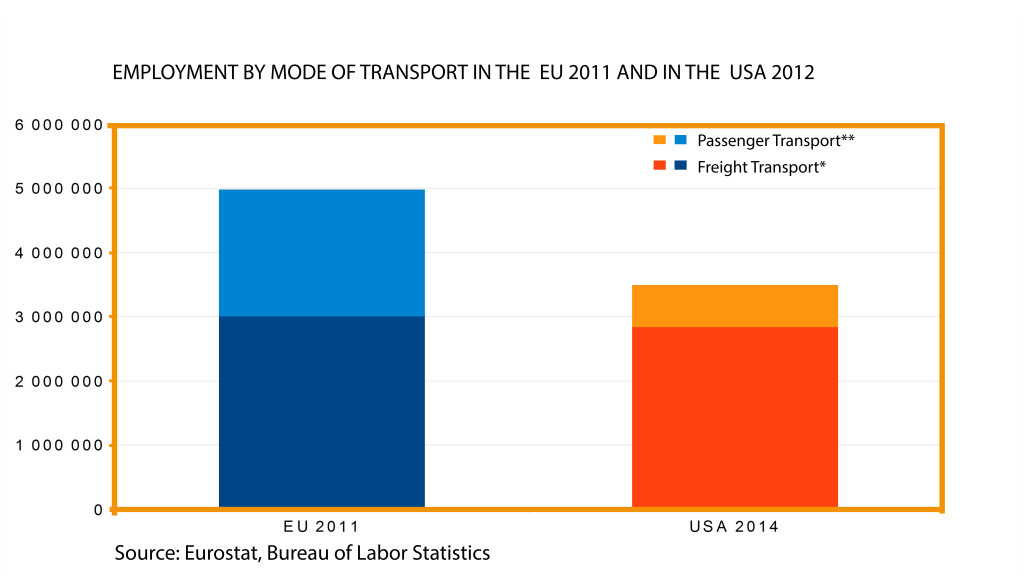Self-driving car and truck technology development is under way to become reality. The question now is not if, but when our cars drive us rather than be driven by us. Engineers and producers like Google, Tesla or Daimler are going into raptures about convenience and possible applications of new driverless cars. But what will happen to over 6,000,000 professional drivers from the European Union and the United States who are in danger of losing their jobs? Has anybody given it a thought?
* Eurostat data refer to transportation and storage activities (including postal and courier services, removal services); U.S. data covers driver/sales workers and truck drivers
** Eurostat data include all urban and suburban land transport modes (motor bus, tramway, streetcar, trolley bus, underground and elevated railways); U.S. data cover bus drivers
Being a truck driver is one of the most common jobs in Europe and in the U.S. The transport sector employs more than 2% of the available labour force of these biggest economies. The estimates of the American Trucker Association claim that there are up to 3,5 million professional truck drivers1. In the EU this amount is probably comparable (the Eurostat delivered proper data only for 2011), while the number of passenger transport drivers is three times as big as that of the U.S. (public transport is much more popular in Europe).
Employment in transport will be increasing until 2020-2022; in the U.S. a shortfall in drivers is expected, but it will be a breakthrough. The „2020 will be the first year to truly see some of these capabilities to start to be introduced in the vehicle,” said Nissan’s Brian Brockman quoted by HybridCars.com2. On the beginning, driverless system can cover the shortfalls, but in a couple of years drivers will be replaced, too. Since 2020, the process should go on quickly and in the years 2025-2030 there will be a capacity to take human drivers out of the road3.
Obviously, not all drivers will lose their jobs because some kind of human control is still necessary. Some of them will also be employed in postal and courier services (someone will have to deliver the package to the addressee). However, as our team estimates, half of the truck or bus drivers may be replaced with driverless systems by 2035. It means a loss of at least about 2,000,000 jobs in the EU and 1,500,000 jobs in the U.S. in a comparatively short time.
Such a (r)evolution will have to affect the labor market and the unemployment rate. While the transport sector has still great perspectives of growth, this development will not entail an increase in employment. Once again, less educated people will find it more difficult to find a job, which can deepen income inequalities within countries. And of course, a lot of small businesses like truck stops and restaurants, reaping the benefits from the services delivered to drivers, will be jeopardized.
The previous tests show that self-driving cars shall raise the level of security on roads and diminish the costs of the transport industry. It would also be a great ‘step towards the future’, inspiring and fulfilling the dreams of many science-fiction writers. However, this modern shift can be stopped by politicians and labor unions ‘worried’ about the social costs and they are not likely to rush with eliminating legal barriers to introduce driverless trucks on our roads.
References
1. Self-Driving Trucks Are Going to Hit Us Like a Human-Driven Truck Source: Medium.com 14-05-2015
Late last year, I took a road trip with my partner from our home in New Orleans, Louisiana to Orlando, Florida and as we drove by town after town…
2. US Could Get Nissan’s First Production Autonomous Cars In 2020 Source: 17-01-2014
Nissan Motors says its first autonomous drive car projected to be on sale in 2020 may be launched initially in the U.S.
3. Driverless convoy: Will truckers lose out to software? Source: BBC 26-05-2015
Sleepiness and stress are perennial risks for the long distance lorry driver, and accidents are sadly too frequent.




